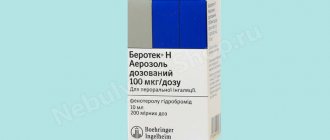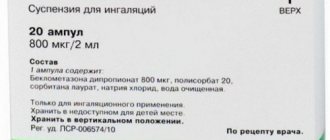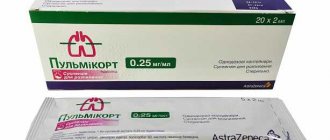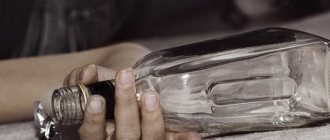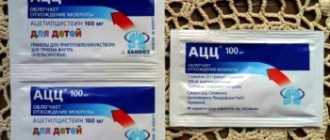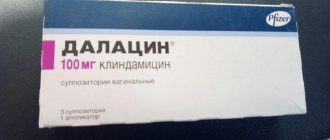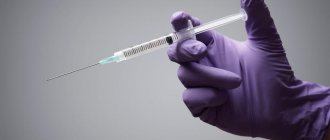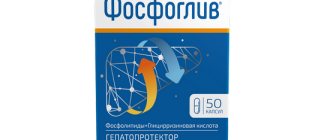Clenil udv for inhalation is considered a strong hormonal drug that allows you to quickly get rid of bronchial asthma attacks. Typically, the medicine is prescribed to patients if standard bronchodilators, which can block spasms by exerting a positive effect on adrenergic receptors, have not had the desired therapeutic effect.
Clenil jet (mn Beclamethasone) is available in the form of an aerosol, which must be used locally. The drug is considered a strong hormonal medication that has the desired therapeutic effect in severe cases of the disease. Using an inhaler on your own is strictly prohibited, as this idea can cause a number of side effects in the patient.
Description, composition and release form of the drug
Clenil jet (international name) is available in the form of a white suspension, which is used for home inhalation by injecting the medicine into the mouth. This liquid can be sedimented, homogeneous or opalescent. When the container is shaken, the consistency of the medication is destroyed.
The solution contains:
- Beclomethasone dipropionate is the main substance of Clenil;
- 4 strips.
The medicine is sold in a cardboard package, inside of which there is an aerosol and instructions for its use. It is important to familiarize yourself with it before starting the procedure, as this way you can learn about all the nuances of home treatment.
Pharmacokinetics
Absorption and Metabolism
In lung tissue, beclomethasone dipropionate is rapidly hydrolyzed to beclomethasone monopropionate, which in turn is hydrolyzed to beclomethasone. The portion of the dose that is inadvertently ingested is largely inactivated on first pass through the liver. In the liver, the process of converting beclomethasone dipropionate into beclomethasone monopropionate and then into polar metabolites occurs.
Distribution
The binding of the active substance in the systemic circulation to plasma proteins is 87%.
Removal
The main part of the drug (35-76%) is excreted within 96 hours with feces, mainly in the form of polar metabolites, 10-15% - by the kidneys.
Pharmacological group and principle of action
Beclomethasone dipropionate, which is the main component of Clenil UDV, is a chemical substance of synthetic origin related to the steroid hormones glucocorticoids. They are produced in small quantities by the human adrenal glands to maintain the full functioning of the body.
After spraying the aerosol, the suspension quickly enters the cells of the mucous layer, after which, with the help of the cytoplasm, it interacts with receptors. As a result of this, the main component of Clenil forms a complex that can bind to the DNA and RNA of the receptor cell, causing a number of changes in it.
The medicine, when used correctly, inhibits enzymatic synthesis, which participates in the mechanism of development of bronchial inflammation. As a result, the medication suppresses the onset of bronchospasm, which allows you to quickly get rid of the symptoms of the disease.
Clenil aerosol is practically not absorbed by the organs of the digestive system, so it is used only locally.
Clenil is endowed with powerful anti-allergic and anti-inflammatory effects, which are formed due to a decrease in the number of mast cells produced by inflammatory mediators. If you use the inhaler correctly, it is possible to reduce the swelling of the epithelium lining the airways.
After home treatment, the production of secretion from the lungs, which resembles mucus, decreases significantly. There is also a decrease in bronchial hyperactivity, regardless of the severity of the attack. Thanks to this, it is possible to quickly normalize the patient’s breathing and restore normal lung function.
Attention! Before starting a course of treatment, the doctor must establish the patient’s sensitivity to standard types of bronchodilators. This will help avoid the development of complications and side effects from taking the medication.
The bioavailability of the drug when administered into the body by inhalation is 60%. The main substance quickly interacts with plasma proteins. The drug is removed from the body through the intestines (the drug leaves the body in a minimal amount through the kidneys). The breakdown of active components occurs in the liver.
Don't miss useful information: Inhalations with saline in a nebulizer for children and adults
Mechanism of action
Clenil UDV for inhalation has the following pharmacokinetics and pharmacodynamics features:
- Upon penetration into the bronchi in the form of a fine aerosol, the active compound is deposited on the surface of the mucosa.
- Beclomethasone molecules enter small blood vessels and then into the systemic circulation. Since this substance has a low degree of hydrophobicity, it requires only 6 minutes to penetrate the mucosal barrier. 87% of the active component binds to blood proteins.
- After the procedure, part of the medication remains in the oral cavity and enters the gastrointestinal tract, but is deactivated in the liver and excreted in the feces in the form of inactive metabolites.
- Under the influence of enzymes, dipropionate is converted into monopropionate, which has a pronounced anti-inflammatory effect.
- Part of the active component forms ester compounds with fatty acids in the cells of the pulmonary epithelium, which do not have hormonal activity. This process is reversible, that is, esters are able to be reduced to the original substance. They can remain in the lungs for a long period, which causes a longer action and reduces the number of required doses to 1 per day. This process also reduces the entry of the drug into the systemic circulation.
Mechanism of action of inhaled glucocorticosteroids - In the lungs, the release of inflammatory mediators decreases.
- The production of lipomodulin increases, which blocks phospholipase A2. This disrupts the release of arachidonic acid, which is converted into prostaglandins. The latter compounds take an active part in the inflammatory process.
- The marginal accumulation of neutrophils and the release of inflammatory exudate are reduced.
- The intensity of migration of macrophages, immune cells that absorb foreign agents, decreases, which also helps slow down infiltration.
- The production of mucus by the bronchial glands decreases.
- The number of β-adrenergic receptors increases, their sensitivity is normalized, thereby restoring the patient’s sensitivity to bronchodilators - drugs to reduce spasms and symptoms of suffocation. This allows you to reduce the frequency of their use.
- The smooth muscles of the bronchi relax, their hyperreactivity to various stimuli decreases, in response to which bronchospasm develops.
- External respiration functions improve.
- The half-life of the active compound is 2-3 hours.
The advantage of this medicine is that it does not have a systemic effect and does not affect mineral metabolism, unlike oral forms of similar drugs. The effect of the active component also persists for some time after the end of treatment.
However, a pronounced therapeutic effect is achieved only after 5-7 days from the start of use. The active substance is also not able to relieve bronchospasm. For a course of treatment, the inhaled form of the drug can serve as a complete alternative to systemic glucocorticosteroids.
Subjectively, the therapeutic effect is manifested in the following:
- reduction in the number of exacerbations;
- easier breathing;
- greater control over symptoms;
- improving quality of life;
- milder course of exacerbations;
- reducing the risk of cardiovascular complications (myocardial infarction, stroke) as a result of reducing the severity of systemic inflammation.
Studies show that short-term courses lasting 1 week in children with frequent bronchial obstruction reduce the incidence of respiratory symptoms, which reduces the likelihood of developing bronchial asthma.
For what diseases is it used?
The instructions for Klenil indicate that inhalation use of the drug is prescribed in the following cases:
- complex treatment of bronchial asthma;
- treatment of hormone-dependent bronchial asthma in children and adults.
Intranasal use of the drug is prescribed to patients for the prevention of rhinitis, which can be seasonal, vasomotor or year-round.
Contraindications for use
The use of the Klenil inhaler should not be carried out in the following cases:
- course of tuberculosis infection;
- pregnancy occurring in the first trimester;
- natural feeding of the baby;
- high sensitivity or intolerance by the body to the components of the medication.
Clenil should be used with caution in the following cases:
- hypothyroidism;
- cirrhosis;
- glaucoma;
- the course of different types of systemic infections;
- viral infectious diseases of the respiratory system;
- second and third trimester of pregnancy.
Since the medicinal composition of the drug is quite strong, it is strictly prohibited to carry out treatment with the drug without a doctor’s testimony.
Rules for inhalation
Clenil aerosol must be used using a nebulizer.
The instructions for use of an ampoule with one dose of the drug say:
- the ampoule needs to be bent in two ways - first by separating it from the top strip, and then from the central section;
- then the container must be shaken well to make the suspension completely dispersed;
- the medicine is opened by turning the lid;
- after this, you need to fill the nebulizer with the amount of the drug prescribed by the doctor;
- unused medicine must be disposed of, since further treatment with it is prohibited.
Attention! Before inhalation, it is important to make sure that the mask fits tightly enough to the face. Otherwise, part of the drug will erode, which will not allow achieving a therapeutic effect.
After the procedure with this form of the drug, it is necessary to rinse your mouth and face with water.
How to properly prepare a solution for procedures?
Clenil UDV for inhalation is used as follows:
- Separate the single-dose ampoule from the rest by turning the plastic packaging where it is sealed.
- Shake the ampoule several times to form a homogeneous suspension.
- Open the lid by turning it counterclockwise.
- Squeeze the contents into the nebulizer reservoir intended for medications. If a portion of the dose is required (for children), you can take the required amount with a disposable syringe. Cover the remaining suspension with a lid.
- Add the required amount of saline solution to the nebulizer to obtain the desired concentration and minimum liquid level in the inhaler.
Precautionary measures
Beclomethasone is not able to relieve acute asthma attacks. Also, it should not be used for severe bronchial asthma, which requires intensive care.
The patient must follow the instructions, which tell them how to use the medicine correctly. It is strictly prohibited to independently exceed the dosage due to the lack of therapeutic effect.
Inhalations under the strict supervision of a doctor are required for problems with the adrenal glands - such patients should undergo regular tests and be shown to a doctor, who will monitor the condition and monitor the effectiveness of home therapy.
If patients take glucocorticosteroids orally for health reasons, treatment with the Clenil inhaler is required only in a stable condition.
If there is a possibility of bronchospasm, 15 minutes before treatment, inhalation with a certain type of bronchodilator is required.
Do not miss useful information: Instructions for use Symbicort Turbuhaler: analogues and dosage
When candidiasis develops in the mouth, patients need to rinse their mouth after each procedure and take medications that fight this disease.
It is prohibited to carry out home treatment with a faulty nebulizer.
Clenil
Release form, composition and packaging
Aerosol for inhalation dosed 1 dose of beclomethasone dipropionate 50 mcg - "- 250 mcg. Excipients: glycerol, norflurane (1,1,1,2-tetrafluoroethane), ethanol.
Clinical and pharmacological group: GCS for inhalation.
pharmachologic effect
GCS for inhalation use. Beclomethasone has anti-inflammatory and antiallergic effects. Under the influence of beclomethasone, the number of mast cells in the bronchial mucosa decreases, the swelling of the epithelium and the secretion of mucus by the bronchial glands decreases. Reduces bronchial hyperreactivity and improves external respiration function. Does not have mineralocorticoid activity. Restores the patient's response to bronchodilators, allowing to reduce the frequency of their use. The therapeutic effect usually develops after 5-7 days of course use of beclomethasone.
Pharmacokinetics
Absorption and Metabolism
In lung tissue, beclomethasone dipropionate is rapidly hydrolyzed to beclomethasone monopropionate, which in turn is hydrolyzed to beclomethasone. The portion of the dose that is inadvertently ingested is largely inactivated on first pass through the liver. In the liver, the process of converting beclomethasone dipropionate into beclomethasone monopropionate and then into polar metabolites occurs.
Distribution
The binding of the active substance in the systemic circulation to plasma proteins is 87%.
Removal
The main part of the drug (35-76%) is excreted within 96 hours with feces, mainly in the form of polar metabolites, 10-15% - by the kidneys.
Indications
- bronchial asthma of mild to moderate severity;
- bronchial asthma of moderate and severe course (including hormone-dependent bronchial asthma, as well as with insufficient effectiveness of bronchodilators and/or sodium cromoglycate).
Dosage regimen
The initial dose of Clenil is selected taking into account the severity of the disease. Depending on the patient's individual response, the dose of the drug can be increased until a clinical effect appears or reduced to the minimum effective dose. Adults (including elderly patients) and children over 12 years of age.
Bronchial asthma of mild severity (forced expiratory volume in 1 second /FEV1/ or peak expiratory flow rate /PEF/ - more than 80%, daily variation in PEF indicators - less than 20%) 200-600 mcg / day for several inhalations.
Bronchial asthma of moderate severity (FEV1 or PEF - 60-80%, daily variation in PEF - 20-30%) 600-1000 mcg / day for several inhalations. Severe bronchial asthma (FEV1 or PEF - 60%, daily variation in PEF - 30%) 1000-2000 mcg/day for several inhalations.
For severe bronchial asthma, Clenil is used, containing 250 mcg of beclomethasone in 1 dose. The maximum daily dose of the drug in adults should not exceed 1000 mcg, in very severe cases - 1500-2000 mcg/day in 3-4 doses.
Children aged 4 to 12 years
The initial dose is 50-100 mcg/day 2 times/day.
If necessary, the dose can be increased to 400 mcg/day in several doses. The maximum daily dose of the drug in children under 12 years of age is 500 mcg. In children, Clenil is used in a form containing 50 mcg of beclomethasone per dose.
The use of Clenil in a form containing 250 mcg of beclomethasone in 1 dose is indicated only if the required daily dose is 500 mcg or more. Clenil containing 250 mcg of beclomethasone in 1 dose should not be suddenly discontinued.
Method of using inhalation aerosol
Before first use (or if the inhaler has not been used for three days or more), remove the protective cap from the mouthpiece and spray the air once.
- Hold the inhaler between your thumb and index finger.
- Remove the protective cap from the inhaler mouthpiece.
- Place the mouthpiece in your mouth, wrap your lips tightly around it, and exhale completely through your nose.
- Take a long, deep breath while simultaneously pressing the end of the can with your index finger.
- After inhaling, hold your breath for as long as possible.
After inhalation, it is advisable to rinse your mouth with water. To keep the mouthpiece clean, it is recommended to rinse it with warm water whenever it becomes dirty.
Side effect
Local reactions: hoarseness, sore throat, cough, candidiasis of the oral cavity and upper respiratory tract (with long-term use and/or when used in high doses), which resolves with local antifungal therapy without stopping treatment.
In isolated cases - paradoxical bronchospasm (relieved by the administration of inhaled bronchodilators), eosinophilic pneumonia, allergic reactions. Systemic reactions: in isolated cases - allergic reactions; with long-term use in doses of more than 1.5 mg/day, a decrease in the function of the adrenal cortex, cataracts, and increased intraocular pressure are possible.
Contraindications
- tuberculosis;
- children under 4 years of age (for the form containing 50 mcg/dose);
- children under 6 years of age (for the form containing 250 mcg/dose);
- hypersensitivity to any of the components of the drug.
Pregnancy and lactation
The drug should be used with caution during pregnancy and lactation. Use in the second and third trimesters of pregnancy is possible only when the expected benefit to the mother outweighs the potential risk to the fetus. If it is necessary to use it during lactation, the issue of stopping breastfeeding should be decided. Infants whose mothers received beclomethasone during pregnancy should be closely monitored for adrenal insufficiency.
Use for liver dysfunction
The drug should be used with caution in patients with liver cirrhosis.
special instructions
The drug should be used with caution in case of liver cirrhosis, epilepsy, cerebral pathology, glaucoma, hypothyroidism, systemic infections (bacterial, fungal, parasitic, viral), osteoporosis. Beclomethasone is not intended for the relief of acute asthmatic attacks. The drug should also not be used for severe attacks of bronchial asthma requiring intensive care. The recommended route of administration for the dosage form used should be strictly followed.
Beclomethasone should be used with extreme caution and under close medical supervision in patients with adrenal insufficiency. The drug contains small amounts of ethanol and glycerol, and therefore caution must be exercised when prescribing the drug to patients with liver cirrhosis, epilepsy and cerebral pathology.
If there is a possibility of developing paradoxical bronchospasm, bronchodilators (for example, salbutamol) are inhaled 10-15 minutes before the administration of beclomethasone. With the development of candidiasis of the oral cavity and upper respiratory tract, local antifungal therapy is indicated without stopping treatment with beclomethasone. Infectious and inflammatory diseases of the nasal cavity and paranasal sinuses, if appropriate therapy is prescribed, are not a contraindication for treatment with beclomethasone.
Use in pediatrics
A drug containing 250 mcg of beclomethasone in 1 dose is usually not prescribed to children under 12 years of age, except in cases where the need for high doses is associated with the severity of the patient's condition.
Overdose
With a single inhalation in doses exceeding average therapeutic values, a slight decrease in the function of the hypothalamic-pituitary-adrenal system is possible, which does not require any emergency measures, and treatment should be continued. The function of the hypothalamic-pituitary-adrenal system is restored after 1-2 days.
Drug interactions
No clinically significant interactions of beclomethasone with other drugs have been identified. Inducers of microsomal oxidation (including phenobarbital, phenytoin, rifampicin) reduce the effectiveness of beclomethasone.
Methandrostenolone, estrogens, beta2-agonists, theophylline and oral corticosteroids enhance the effect of beclomethasone. Beclomethasone enhances the effects of beta2-agonists. Previous inhaled use of beta2-agonists may increase the clinical effectiveness of beclomethasone. Due to the small amount of ethanol contained, there is a theoretical possibility of interaction with disulfiram or metronidazole in hypersensitive patients.
Storage conditions and periods
List B. The drug should be stored out of direct sunlight and out of reach of children, away from heating devices, at a temperature not exceeding 30°C; do not freeze. Shelf life: 3 years. The cylinder is under pressure - do not expose it to high temperatures, do not pierce it, do not throw it into fire, even when empty.
Side effects
Rarely, but still, after using the drug, patients observe side effects. These include mainly local symptoms, such as:
- hoarseness in the voice;
- sore throat;
- itching;
- frequent sneezing;
- irritation of the nasal membrane;
- reflex cough.
Patients often notice the development of candidiasis in the mouth as a result of inhalation therapy with Klenil. In this case, the patient is prescribed antifungal treatment (there is no need to stop taking Clenil).
Incorrect use of a hormonal drug can lead to the development of eosinophilic pneumonia. This condition is characterized by the accumulation of a significant number of leukocytes in the alveoli, which can cause a serious process of inflammation.
Negative health allergic manifestations caused by Klenil:
- allergic dermatitis;
- hives;
- irritation and itching on the skin;
- swelling of the face.
The following side effects are rarely observed in children:
- growth retardation or arrest;
- the development of bone fragility, which occurs as a result of a decrease in the amount of minerals in their structure.
Side effects affecting the central nervous system include:
- sleep disturbance;
- causeless anxiety;
- headaches and dizziness;
- irritability and crying (usually seen in children);
- increased pressure inside the eyes;
- development of cataracts.
Judging by the reviews of doctors, patients’ blood composition may be disrupted due to an increase in the level of leukocytes and a decrease in lymphocytes.
Regimen and dosage
Clenil UDV is prescribed to patients only for inhalation treatment. The medicine must be administered using a nebulizer, which has a mouthpiece and a special face mask.
Attention! The dosage is selected by the doctor individually for each patient.
For adults
The usual dose for an adult is one ampoule 2 times a day. The ampoule contains 400 mcg, which is enough to provide a lasting therapeutic effect. If necessary, the doctor may increase the dose of the medication based on the patient's health condition.
For children
A single dosage of Clenil for children is 50-100 mcg. It is permissible to carry out inhalations 2-4 times a day. At the same time, it is important to constantly monitor the dose of the medication, since exceeding it can negatively affect the child’s health.
Overdose
If the dose of Clenil is significantly exceeded, intoxication of the body occurs, which causes a sharp disruption of hormonal levels. This condition does not require medical treatment as it goes away on its own within a few days. In this case, the patient does not need to temporarily stop the course of treatment with Klenil or reduce its dosage.
If the patient frequently violates the dose prescribed by the doctor, this will contribute to the suppression of adrenal functions, which will ultimately lead to hypercortisolism. In this case, the patient will be completely discontinued and given symptomatic therapy.
Overdose
If the recommended dose is exceeded once, a short-term deterioration of the hypothalamic-pituitary-adrenal system is possible, manifested in the form of increased fatigue, weakness, and decreased blood pressure.
This condition does not require special treatment, since functions are restored within 1-2 days on their own. If an overdose occurs systematically, depletion of the adrenal cortex may develop, which requires appropriate therapy.
The safety of the drug suspension was confirmed in clinical trials, during which the concentration of the active component was 2 and 4 times higher than the recommended one. Due to the short half-life, total systemic exposure was negligible.
special instructions
The aerosol version of the medication is called Clenil Jet. In this case, the main substance remains unchanged (beclazone), and the auxiliary substances are glycerol and norflurane. This form of the drug is available without water.
Attention! The drug can only treat bronchial asthma.
The maximum dose of medication for an adult is 4 inhalations per day, and for children 6-12 years old - 2.
Do not miss useful information: Instructions for use of Flixotide for inhalation
The duration of home inhalations depends on the doctor’s indications.
Attention! The spray can provide a comprehensive therapeutic effect only if it is used strictly according to the instructions.
Features of treatment
People of different ages and health conditions should use Clenil at home carefully. For example, elderly patients are not recommended to carry out inhalations for a long time, as this can lead to breathing problems.
In childhood
For a child, the main feature of therapy is the correct selection of dosage. Children need to breathe through a special face mask, which will prevent the medicine from being sprayed into the environment. The child’s inhalations and exhalations should be calm and slow, which will allow the drug to be better distributed throughout the mucous layer of the bronchi.
During pregnancy and pregnancy
In the 2nd and 3rd trimester, home inhalations are allowed only if the benefit to the mother outweighs the possible risk to the child growing in the womb. Newborns whose mothers were forced to take medication during pregnancy should be carefully examined and assessed for the condition of the adrenal glands.
During breastfeeding, Klenil and its substitutes are best taken during temporary cessation of lactation. This is done if the woman, for health reasons, cannot be helped by other remedies.
Interaction with other drugs
Doctors say that Klenil is compatible with any medications. An overview of medications that may slightly weaken the therapeutic effect of the medication in question:
- Phenobarbital;
- Rifampicin;
- Phenytoin.
Drugs that enhance the effect of Clenil UDV:
- Methandienone;
- Theophylline;
- Fenoterol;
- Salbutamol.
If a patient needs to take any medications for health reasons, this must be reported to the attending physician. Then he will be able to choose the right dose of medicine that will not harm the patient’s health.
Instructions for Klenil for inhalation
Instructions for use of Klenil for inhalation:
- Bend the ampoule in two different directions - it is made of plastic.
- Disconnect the ampoule from the upper fastening strip and the middle fixing block.
- Shake the already separated ampoule several times in your hand - the suspension should become homogeneous, the emulsification should be complete.
- Open the ampoule by turning the cap clockwise and removing it.
- Press on the plastic (it is soft), squeeze out the required amount of the drug through the hole into the container for nebulizer solutions.
If not all of the suspension from the ampoule is used, the remainder can be stored for 24 hours by closing the hole with the back of the removed cap.
During inhalation, it is important to monitor how the mask fits to the patient’s face - if steam escapes during the procedure, there may be no therapeutic effect. After the manipulation, you must wash your face and rinse your mouth with warm water.
How to dilute with saline, dosage for children and adults
The suspension should be diluted with saline solution in a 1:1 ratio, and this can be done directly in the nebulizer container. Dosage for adults – 1 ampoule (2 ml) twice a day, but the doctor can increase the dose if necessary.
For children, the dosage should be reduced - ½ ampoule of the drug is used for one inhalation, the number of procedures per day is a maximum of 3, in especially severe cases it can be increased to 4.
The dosage is determined by the doctor on a strictly individual basis; it can be reduced or increased depending on the patient’s condition.
Possible complications when used in a nebulizer
Inhalations carried out with a nebulizer with the drug Clenil can cause some side effects and complications:
- sore throat and hoarseness of voice;
- frequent sneezing;
- itching in the mouth, in the lips;
- dry reflex cough.
Sometimes patients notice the development of thrush in the mouth, in which case they are prescribed antifungal drugs, but therapy with the drug in question is not stopped.
In addition, the following are considered complications after inhalation with Klenil:
- swelling of the face;
- classic symptoms of urticaria;
- sleep disturbance (trouble falling asleep);
- headaches, slight dizziness;
- increased intraocular pressure;
- progression of cataracts.
In childhood, a delay or complete stop in the child’s growth and a decrease in minerals in bone tissue (bone fragility) are possible.
Rarely, but sometimes there is an increase in the number of leukocytes and a decrease in lymphocytes - this is determined by control blood tests.
Is there an overdose?
If the patient strictly follows the dosage prescribed by the doctor, then there is no case of overdose. In all other cases, exceeding the dose of Clenil leads to severe intoxication of the body, and this negatively affects hormonal levels. Even if this happens, doctors do not prescribe any specific treatment; the patient’s condition normalizes on its own in literally 1-3 days.
If the dosage is exceeded regularly, then adrenal function is suppressed, and the result will be the progression of hypercortisolism.
This is considered a serious complication, so doctors cancel Klenil therapy.
special instructions
The official instructions for the drug contain special instructions:
- do not try to stop acute attacks of bronchial asthma with Klenil;
- sometimes therapy can cause the development of eczema or allergic rhinitis;
- patient complaints of pain in joints and muscles are possible;
- rarely, but the first inhalations can cause the patient to experience attacks of nausea and vomiting;
- Ampoules are stored only in a vertical position.
Doctors do not recommend long-term inhalations for elderly people, as this provokes breathing problems.
Drug interactions
Clenil combines well with any medications, which is why it is used as an additional agent in complex therapy.
Some medications can reduce the effectiveness of inhalations:
- Rifampicin,
- Phenobarbital,
- Phenytoin.
And other drugs enhance the effect of Clenil on the bronchial mucosa:
- Fenoterol,
- Salbutamol,
- Methandienone,
- Theophylline.
Fenoterol Salbutamol Methandienone Theophylline
If the patient, due to his health condition, is forced to take some medications on a regular basis, then the doctor must be informed about this - he will be able to select an adequate dose of Clenil.
Storage rules and expiration date
The shelf life of the medicinal product is 2 years. The drug should be stored at a temperature of no more than 25 degrees away from light and heating devices. It is advisable to store ampoules upright.
After opening the aluminum packaging, the ampoules can be stored for no more than 3 months under the previously described conditions.
